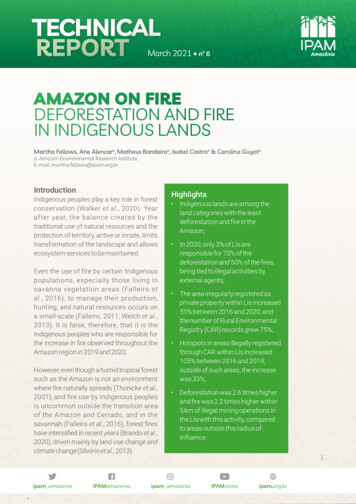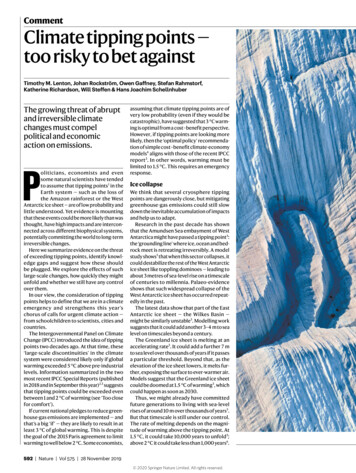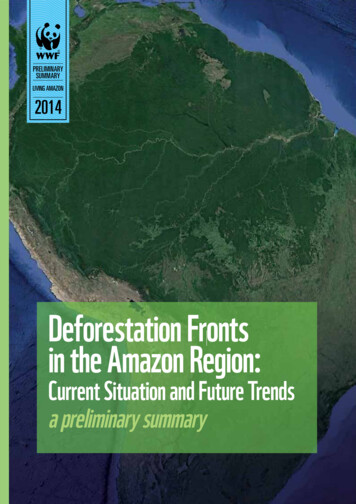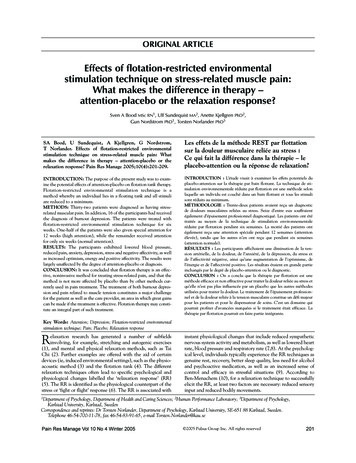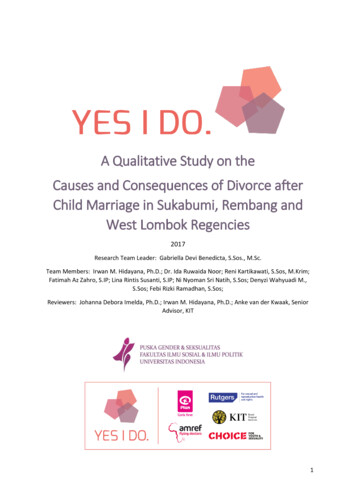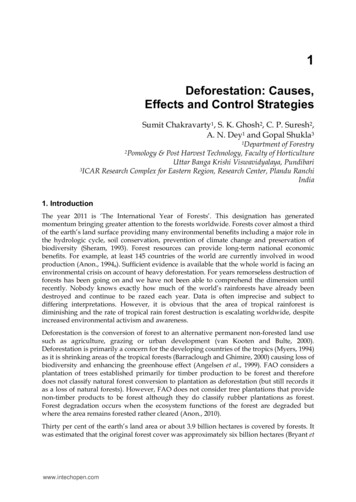
Transcription
1Deforestation: Causes,Effects and Control StrategiesSumit Chakravarty1, S. K. Ghosh2, C. P. Suresh2,A. N. Dey1 and Gopal Shukla31Department of Forestry& Post Harvest Technology, Faculty of HorticultureUttar Banga Krishi Viswavidyalaya, Pundibari3ICAR Research Complex for Eastern Region, Research Center, Plandu RanchiIndia2Pomology1. IntroductionThe year 2011 is ‘The International Year of Forests’. This designation has generatedmomentum bringing greater attention to the forests worldwide. Forests cover almost a thirdof the earth’s land surface providing many environmental benefits including a major role inthe hydrologic cycle, soil conservation, prevention of climate change and preservation ofbiodiversity (Sheram, 1993). Forest resources can provide long-term national economicbenefits. For example, at least 145 countries of the world are currently involved in woodproduction (Anon., 1994a). Sufficient evidence is available that the whole world is facing anenvironmental crisis on account of heavy deforestation. For years remorseless destruction offorests has been going on and we have not been able to comprehend the dimension untilrecently. Nobody knows exactly how much of the world’s rainforests have already beendestroyed and continue to be razed each year. Data is often imprecise and subject todiffering interpretations. However, it is obvious that the area of tropical rainforest isdiminishing and the rate of tropical rain forest destruction is escalating worldwide, despiteincreased environmental activism and awareness.Deforestation is the conversion of forest to an alternative permanent non-forested land usesuch as agriculture, grazing or urban development (van Kooten and Bulte, 2000).Deforestation is primarily a concern for the developing countries of the tropics (Myers, 1994)as it is shrinking areas of the tropical forests (Barraclough and Ghimire, 2000) causing loss ofbiodiversity and enhancing the greenhouse effect (Angelsen et al., 1999). FAO considers aplantation of trees established primarily for timber production to be forest and thereforedoes not classify natural forest conversion to plantation as deforestation (but still records itas a loss of natural forests). However, FAO does not consider tree plantations that providenon-timber products to be forest although they do classify rubber plantations as forest.Forest degradation occurs when the ecosystem functions of the forest are degraded butwhere the area remains forested rather cleared (Anon., 2010).Thirty per cent of the earth’s land area or about 3.9 billion hectares is covered by forests. Itwas estimated that the original forest cover was approximately six billion hectares (Bryant etwww.intechopen.com
4Global Perspectives on Sustainable Forest Managemental., 1997). The Russian Federation, Brazil, Canada, the United States of America and Chinawere the most forest rich countries accounting to 53 per cent of the total forest area of theglobe. Another 64 countries having a combined population of two billions was reported tohave forest on less than ten per cent of their total land area and unfortunately ten of thesecountries have no forest at all. Among these countries 16 are such which had relativelysubstantial forest areas of more 1than one million hectares each and three of these countriesnamely Chad, the Islamic Republic of Iran and Mongolia each had more than ten millionhectares of forest. The forest area remained fairly stable in North and Central America whileit expanded in Europe during the past decade. Asian continent especially in India and Chinadue to their large scale afforestation programme in the last decade registered a net gain inforest area. Conversely the South America, Africa and Oceania had registered the net annualloss of forest area (Anon., 2010; 2011a).2. World deforestationAccording to Professor Norman Myers, one of the foremost authorities on rates ofdeforestation in tropical forests, “the annual destruction rates seems set to accelerate furtherand could well double in another decade” (Myers, 1992). Mostly deforestation has occurredin the temperate and sub-tropical areas. Deforestation is no longer significant in thedeveloped temperate countries now and in fact many temperate countries now arerecording increases in forest area (Anon., 1990a; 2010). In most instances developed nationsare located in temperate domains and developing nations in tropical domains. Howeverdeforestation was significantly less in tropical moist deciduous forest in 1990-2000 than1980-1990 but using satellite imagery it was found that FAO overestimated deforestation oftropical rainforests by 23 per cent (Anon., 2001a; b). However the definition of what is andwhat is not forest remains controversial. The tropical rainforests capture most attention but60 per cent of the deforestation that occurred in tropical forests during 1990-2010 was inmoist deciduous and dry forests.However extensive tropical deforestation is a relatively modern event that gainedmomentum in the 20th century and particularly in the last half of the 20th century. TheFAO FRA 2001 and 2010 reports indicate considerable deforestation in the world during1990-2010 but this was almost entirely confined to tropical regions (Anon., 2001a; 2010). Asummary of deforestation during the decades 1990-2010 is given in tables 1 and 2. Thesetables show there was considerable deforestation in the world during 1990-2010 but thiswas almost entirely confined to tropical regions. Rowe et al. (1992) estimated that 15 percent of the world’s forest was converted to other land uses between 1850 and 1980.Deforestation occurred at the rate of 9.2 million hectares per annum from 1980-1990, 16million hectares per annum from 1990-2000 and decreased to 13 million hectares perannum from 2000-2010. The net change in forest area during the last decade wasestimated at -5.2 million hectares per year, the loss area equivalent to the size of CostaRica or 140 km2 of forest per day, was however lesser than that reported during 1990-2000which was 8.3 million hectares per year equivalent to a loss of 0.20 per cent of theremaining forest area each year. The current annual net loss is 37 per cent lower than thatin the 1990s and equals a loss of 0.13 per cent of the remaining forest area each yearduring this period. By contrast some smaller countries have very high losses per year andthey are in risk of virtually losing all their forests within the next decade if current rates ofwww.intechopen.com
5Deforestation: Causes, Effects and Control Strategiesdeforestation are maintained. Indeed some 31 countries do not even make the list becausethey have already removed most of their forests and even if that remain are seriouslyfragmented and degraded. The changes in area of forest by region and subregion areshown in table 1.Region/subregionEastern and Southern AfricaNorthern AfricaWestern and Central AfricaTotal AfricaEast AsiaSouth and Southeast AsiaWestern and Central AsiaTotal AsiaRussian Federation (RF)Europe excluding RFTotal EuropeCaribbeanCentral AmericaNorth AmericaTotal North and Central AmericaTotal OceaniaTotal South AmericaWorld1990-20001 000 .45-0.202000-20101 000 45-0.13Table 1. Annual change in forest area by region and subregion, 1990-2010(Source: Anon., 2010)South America with about four million hectares per year suffered the largest net loss offorests during the last decade followed by Africa with 3.4 million hectares annually and theleast Oceania with seven lakh hectares annually. Oceania suffered mainly due to Australiawhere severe drought and forest fires from 2000 AD had exacerbated their loss. Both Braziland Indonesia had the highest net loss of forest during the decade of 1990 but hassignificantly reduced their rate of loss after this decade. Brazil and Indonesia dominateaccounting for almost 40 per cent of net forest loss over the decade of 1990s. Even thoughBrazil was the top deforesting country by area, the forests in Brazil are so extensive that thisrepresents a loss of 0.4 per cent per year. The forest area in North and Central Americaremained stable during the past decade. The forest area in Europe continued to expandalthough at a slower rate of seven lakh hectare per year during the last decade than in the1990s with nine lakh hectares per year. Asia lossed some six lakh hectares annually during1990s but gained more than 2.2 million hectares per year during the last decade. The tencountries with the largest net loss per year in the period 1990-2000 AD had a combined netloss of forest area of 7.9 million hectares per year. In the period 2000-2010 AD this wasreduced to six million hectares per year as a result of reductions in Indonesia, Sudan, Braziland Australia (table 1). There were 28 countries and areas which have an estimated net lossof one per cent or more of their forest area per year. The five countries with the largestwww.intechopen.com
6Global Perspectives on Sustainable Forest Managementannual net loss for 2000-2010 AD were Comoros (-9.3 per cent), Togo (-5.1 per cent), Nigeria(-3.7 per cent), Mauritania (-2.7 per cent) and Uganda (-2.6 per cent). The area of otherwooded land globally decreased by about 3.1 million hectares per year during 1990-2000 ADand by about 1.9 million hectares per year during the last decade. The area of other woodedland also decreased during the past two decades in Africa, Asia and South anzaniaMexicoZimbabweCongoArgentinaTotalAnnual change1990-20001 000 nzaniaZimbabwethe CongoMyanmarBoliviaVenezuelaTotalAnnual change1990-20001 000 6040-0.53Table 2. Countries with largest annual net loss of forest area, 1990-2010 (Source: Anon., 2010)3. The causes of deforestationAs Myers pointed out, “we still have half of all tropical forests that ever existed” (Myers,1992). The struggle to save the world’s rainforests and other forests continues and there is agrowing worldwide concern about the issue. In order to save forests, we need to know whythey are being destroyed. Distinguishing between the agents of deforestation and its causesis very important in order to understand the major determinants of deforestation. Theagents of deforestation are those slash and burn farmers, commercial farmers, ranchers,loggers, firewood collectors, infra-structure developers and others who are cutting down theforests. Causes of deforestation are the forces that motivate the agents to clear the forests.However, most of the existing literature typically distinguishes between two levels ofspecific factors: direct and indirect causes of deforestation. Direct agents and causes ofdeforestation, also typically referred to as sources of deforestation, first level or proximatecauses (Panayotou, 1990; Barbier et al., 1994; Caviglia, 1999) are relatively easy to identifybut the indirect causes which are usually the main divers of deforestation are the ones thatcause most disagreement and the ones that are hardest to quantify (Bhatnagar, 1991; Mather,1991; Humphreys, 2006; Sands, R. 2005).Similarly, Pearce and Brown (1994) identified two main forces affecting deforestation.They are:-Competition between humans and other species for the remaining ecological niches onland and in coastal regions. This factor is substantially demonstrated by the conversionof forest land to other uses such as agriculture, infrastructure, urban development,industry and others.www.intechopen.com
Deforestation: Causes, Effects and Control Strategies-7Failure in the working of the economic systems to reflect the true value of theenvironment. Basically, many of the functions of tropical forests are not marketed andas such are ignored in decision making. Additionally, decisions to convert tropicalforests are themselves encouraged by fiscal and other incentives.The former can be regarded as the direct and latter as indirect cause of deforestation.3.1 Direct causes3.1.1 Expansion of farming landAbout 60 per cent of the clearing of tropical moist forests is for agricultural settlement(Myers, 1994; Anon., 1991) with logging and other reasons like roads, urbanization andFuelwood accounting for the rest (Anon., 1994b). Tropical forests are one of the last frontiersin the search for subsistence land for the most vulnerable people worldwide (Myers, 1992).Millions of people live on the tropical forest with less than a dollar a day where a third of abillion are estimated to be foreign settlers. However, as the land degrades people are forcedto migrate, exploring new forest frontiers increasing deforestation (Wilkie et al., 2000; Amor,2008; Amor and Pfaff, 2008). Deforestation is proxied by the expansion of agricultural land.This is because agricultural land expansion is generally viewed as the main source ofdeforestation contributing around 60 per cent of total tropical deforestation.Shifting agriculture also called slash and burn agriculture is the clearing of forested land forraising or growing the crops until the soil is exhausted of nutrients and/or the site isovertaken by weeds and then moving on to clear more forest. It is been often reported as themain agent of deforestation. Smallholder production in deforestation and the growingnumber of such producers notably shifting cultivators were the main cause of deforestation(Anon., 1990b; c; Dick, 1991; Anon., 1992a; b; Barbier et al., 1993; Ascher, 1993; Dove, 1993;1996; Dauvergne, 1994; Porter, 1994; Thiele, 1994; Anon., 1994c; Angelsen, 1995; Ross, 1996).Mostly all reports indicate shifting agriculture as responsible for about one half of tropicaldeforestation and some put it up to two-thirds. Shifting agriculture was greatest in Asia(about 30 per cent) but only about 15 per cent over the whole tropical world. It appears thatthe proportion of direct conversion of forest to agriculture is increasing and the proportionof shifting agriculture is decreasing with time.3.1.2 Forest and other plantationsPlantations are a positive benefit and should assist in reducing the rate of deforestation. Thefact that plantations remove the timber pressure on natural forests does not translateeventually into less, but rather into more deforestation. Indeed, it is feared that agriculturalexpansion which is the main cause of deforestation in the tropics might replace forestry inthe remaining natural forests (Anon., 2002; Cossalter and Pye-Smith, 2003; Anon., 2005). Theimpact of timber plantations could thus turn out to be quite detrimental to tropical forestecosystems (Kartodihardjo and Supriono, 2000). Tree crops and rubber in particular plays amore important role in deforestation in Indonesia than subsistence-oriented shiftingcultivation (Chomitz and Griffiths, 1996). Unfortunately about one-half of the plantations inthe tropics are established on native forest cleared for the purpose. Moreover plantationscan promote deforestation by constructing roads that improve access of the shiftingcultivators and others to the forest frontier.www.intechopen.com
8Global Perspectives on Sustainable Forest Management3.1.3 Logging and fuel woodLogging does not necessarily cause deforestation. However, logging can seriously degradeforests (Putz et al., 2001). Logging in Southeast Asia is more intensive and can be quitedestructive. However, logging provides access roads to follow-on settlers and log scales canhelp finance the cost of clearing remaining trees and preparing land for planting of crops orpasture. Logging thus catalyzes deforestation (Chomitz et al., 2007).Fuelwood gathering is often concentrated in tropical dry forests and degraded forest areas(Repetto, 1988; 1990; Rowe et al., 1992; Anon., 1994a). Fuelwood is not usually the majorcause of deforestation in the humid tropics although it can be in some populated regionswith reduced forest area such as in the Philippines, Thailand and parts of Central America.Fuelwood gathering was considered to be the main cause of deforestation and forestdegradation in El Salvador (Repetto, 1990). In the drier areas of tropics, Fuelwood gatheringcan be a major cause of deforestation and degradation.3.1.4 OvergrazingOvergrazing is more common in drier areas of the tropics where pastures degraded byovergrazing are subject to soil erosion. Stripping trees to provide fodder for grazinganimals can also be a problem in some dry areas of the tropics but is probably not a majorcause of deforestation. Clear cutting and overgrazing have turned large areas of Qinghaiprovince in China into a desert. Overgrazing are causing large areas of grasslands northof Beijing and in Inner Mongolia and Qinghai province to turn into a desert. One manwho lived in a village on the eastern edge of the Qinghai-Tibet plateau that was beingswallowed up by sand told the New York Times, "The pasture here used to be so greenand rich. But now the grass is disappearing and the sand is coming.” Huge flocks of sheepand goats strip the land of vegetation. In Xillinggol Prefecture in Inner Mongolia, forexample, the livestock population increased from 2 million in 1977 to 18 million in 2000,turning one third of the grassland area to desert. Unless something is done the entireprefecture could be uninhabitable by 2020. Overgrazing is exacerbated by sociologicalphenomena called "the tragedy of the common." People share land but raises animals forthemselves and try to enrich them by rising as many as they can. This leads to moreanimals than the land can support. Grassland in Qinghai that can support 3.7 millionsheep had 5.5 million sheep in 1997. Animals remove the vegetation and winds finishedthe job by blowing away the top soil, transforming grasslands into desert. When a herderwas asked why he was grazing goats next to a sign that said “Protect vegetation, nograzing,” he said, “The lands are too infertile to grow crops—herding is the only way forus to survive.” (Hays, 2008 web page).3.1.5 FiresFires are a major tool used in clearing the forest for shifting and permanent agriculture andfor developing pastures. Fire is a good servant but has a poor master. Fire used responsiblycan be a valuable tool in agricultural and forest management but if abused it can be asignificant cause of deforestation (Repetto, 1988; Rowe et al., 1992). Based on the dataavailable from 118 countries representing 65 per cent of the global forest area, an average of19.8 million hectares or one per cent of all forests were reported to be significantly affectedwww.intechopen.com
Deforestation: Causes, Effects and Control Strategies9each year by forest fires (Anon., 2010). Deforestation due to road pavements in Brazil hadalso lead to higher incidences of forest fires (Carvalho et al., 2001; Nepstad et al., 2001).3.1.6 MiningMining is very intensive and very destructive (Mather, 1991; Sands, 2005). The area of landinvolved is quite small and it is not seen as a major cause of primary deforestation. Miningis a lucrative activity promoting development booms which may attract population growthwith consequent deforestation. The deforestation rate due to mining activities in Guyanafrom 2000 to 2008 increased 2.77 times according to an assessment by the World WildlifeFund-Guianas (Staff, 2010). Similarly, in the Philippines, mining, along with logging, hasbeen among the forces behind the country’s loss of forest cover: from 17 million hectares in1934 to just three million in 2003 or an 82 per cent decline (Docena, 2010). Nearly 2,000hectares of tropical forest in the Municipality of Coahuayana in the State of Michoacán(south-western Mexico) will completely be destroyed by mining iron minerals planned bythe Italo-Argentine mining company TERNIUM (Anonymous, 2008). Similarly, Nyamagarihills in Orissa India currently threatened by Vedanta Aluminum Corporation's plan to startbauxite mining will destroy 750 hectares of reserved forest (Griffiths and Hirvelä, 2008).Massive and unchecked mining of coal, iron ore and bauxite in Jharkhand, India has causedlarge scale deforestation and created a huge water scarcity (Anon., 2011b). In return forUS 3.8 billion of investment, the agreements between the State government of Jharkhand,India and mining companies, there will be a massive land acquisition which will deforest noless than 57,000 hectares of forest and displace 9,615 families, many of them located inlegally protected Scheduled Areas set aside for indigenous peoples in the State (Mullick andGriffiths. 2007). Moreover, Roads constructed to support the mining operations will openup the area to shifting agriculturists, permanent farmers, ranchers, land speculators andinfrastructure developers. For instance the core of Brazil’s Amazon development strategywere infra-structure development projects such as roads providing access to frontierregions, mining area and large hydroelectric reservoirs (Mahar, 1988; Fearnsideand Barbosa, 1996; Carvalho et al., 2002, 2004). The construction of roads, railways,bridges, and airports opens up the land to development and brings increasing numbers ofpeoples to the forest frontier. If wood is used as fuel in mining operations and it is sourcesfrom plantations established for the purpose, it can cause serious deforestation in theregion. On the other hand, mining can be labour intensive and take labour away fromclearing forest.3.1.7 Urbanization/industrialization and infra-structureExpanding cities and towns require land to establish the infrastructures necessary tosupport growing population which is done by clearing the forests (Mather, 1991; Sands,2005). Tropical forests are a major target of infra-structure developments for oilexploitation, logging concessions or hydropower dam construction which inevitablyconveys the expansion of the road network and the construction of roads in pristine areas(Kaimowitz and Angelsen, 1998). The construction of roads, railways, bridges, andairports opens up the land to development and brings increasing numbers of people tothe forest frontier. Whether supported or not by the governmental programmes, thesesettlers have usually colonized the forest by using logging trails or new roads to accesswww.intechopen.com
10Global Perspectives on Sustainable Forest Managementthe forest for subsistence land (Wilkie et al., 2000; Amor, 2008; Amor and Pfaff, 2008).(Wilkie et al., 2000; Amor, 2008; Amor and Pfaff, 2008). The development of these infrastructure projects are of worldwide concern, since tropical forest clearing accounts forroughly 20 per cent of anthropogenic carbon emissions destroying globally significantcarbon sinks (Anon., 2001c) and around 21 per cent of tropical forests have been lostworldwide since 1980 (Bawa et al., 2004).3.1.8 Air pollutionAir pollution is associated with degradation of some European and North Americanforests. The syndrome is called “Waldsterben” or forest death. In 1982, eight per cent of allWest German trees exhibited damage that rose to about 52 per cent by 1987 (Raloff, 1989)and half of the trees reported dying of Waldsterben in the Alps (Lean, 1990). Highelevation forests show the earliest damage including forests in the north-east and centralUnited States.3.1.9 Wars and role of the militaryIt is well established that military operations caused deforestation during the VietnamWar and elsewhere (Mather, 1991; Sands, 2005). More recently, linkages have beendocumented between the civil war in Myanmar and the timber trade between Myanmarand Thailand. Myanmar regime sells timber to the Thais to finance its civil war against theKaren hill tribe. Forest destruction in El Salvador has resulted from war. Apart frommilitary involvements in wars, the role of military in deforestation has been documentedin Southeast Asia and South America (Mather, 1991; Sands, 2005). The authors alsoobserved that role of powerful military in Brazilian politics are a major cause ofAmazonian forest destruction.3.1.10 TourismNational parks and sanctuaries beyond doubt protect the forests, but uncautioned andimproper opening of these areas to the public for tourism is damaging. Unfortunately, thenational governments of tropical and sub-tropical countries adopt tourism for easy way ofmaking money sacrificing the stringent management strategies. Further, many companiesand resorts who advertise themselves as eco-tourist establishments are in fact exploiting theforests for profit. In Cape Tribulation, Australia, for example, the rain forest is beingthreatened by excessive tourism (Colchester and Lohmann, 1993). Similarly, in the TeraiDuars of eastern India foothill Himalaya, eco-tourism is encouraged and we fear this isbeing done without developing adequate management plans. For instance, the ChilapattaReserve Forest in this area is opened for eco-tourism for its ancient ruins deep in the forestand a tree species Myristica longifolia that exudes a blood like sap when injured. The site hasbecome a popular eco-tourist destination because of the ruins and for this blood exudingtree. In the whole forest only eight individuals were found but two of the trees in the nearvicinity of the ruins completely dried away due to repeated injuries caused to the plants bythe curious tourists (Shukla, 2010). In fact, in the name of eco-tourism, infra-structuredevelopment is taking place mostly be the private players in these wilderness areas whichare further detrimental in terms of attracting peoples other than tourists also, causingdeforestation especially deep in the forest.www.intechopen.com
Deforestation: Causes, Effects and Control Strategies113.2 Indirect causesThe World Rainforest Movement’s ‘Emergency Call to Action for the forests and theirPeoples’ asserts that “deforestation is the inevitable result of the current social and economicpolicies being carried out in the name of development” (Anon., 1990d). It is in the name ofdevelopment that irrational and unscrupulous logging, cash crops, cattle ranching, largedams, colonisation schemes, the dispossession of peasants and indigenous peoples andpromotion of tourism is carried out. Harrison Ngau, an indigenous tribesman fromSarawak, Malaysia and winner of the Goldman Environment Award in 1990 puts the causeof tropical deforestation like this, “the roots of the problem of deforestation and waste ofresources are located in the industrialized countries where most of our resources such astropical timber end up. The rich nations with one quarter of the world’s populationconsume four fifth of the world’s resources. It is the throw away culture of theindustrialized countries now advertised in and forced on to the Third World countries thatis leading to the throwing away of the world. Such so-called progress leads to destructionand despair” (Anon., 1990d)! Such a development leads to overconsumption which is thebasic underlying cause of deforestation.3.2.1 ColonialismErstwhile colonies of the colonial powers like Britain, France, Spain or Portugal are now theThird World Countries or the developing nations mostly have the tropical rainforests exceptAustralia and Hawaii were exploited for their natural resources and their indigenouspeople’s rights destroyed by the colonial powers. All these countries have indigenouspopulations who had their own system of land management and/or ownership in place forthousands of years before the intervention of colonists from rich industrialized nations.Colonialism turned previously self-sufficient economies into zones of agriculture exportproduction. This process continues even today in different form of exploitation and thesituation is worsening (Colchester and Lohmann, 1993).3.2.2 Exploitation by industrialized countriesWealthy countries or the erstwhile colonial powers having deficit of their own naturalresources are mainly sustaining on the resources of the financially poorer countries those aregenerally natural resource rich. Twenty per cent of the world’s population is using 80 percent of the world’s resources. Unfortunately also the governments of these poor resourcerich countries had generally adopted the same growth-syndrome as their westernneighbours or their erstwhile colonial master giving emphasis on maximizing exports,revenues and exploiting their rich natural resources unsustainably for short-term gains.Moreover, corruption in government, the military and economic powers is well known. Theproblem is further worsened by the low price of the most Third World exports beingrealized in the international market (Colchester and Lohmann, 1993).3.2.3 The debt burdenPursuing the guided development agenda, the financially poorer countries are on a heavyinternational debt and now feeling the urgency of repaying these huge debts due toescalating interest rates. Such a situation compels these debt ridden poorer countries towww.intechopen.com
12Global Perspectives on Sustainable Forest Managementexploit their rich natural resources including their forests partly to earn foreign exchange forservicing their debts. For instance, construction of roads for logging operations in someSouth-east Asian countries was funded by Japanese aid which allowed the Japanese timbercompanies to exploit the forests of these countries. Understandably, these timber companiesprofitably exploited the forests while the South-east Asian countries were left owing Japanmoney for construction of their roads (Colchester and Lohmann, 1993).3.2.4 Overpopulation and povertyThe role of population in deforestation is a contentious issue (Mather, 1991; Colchester andLohman
Global Perspectives on Sustainable Forest Management 6 annual net loss for 2000-2010 AD were Comoros (-9.3 per cent), Togo (-5.1 per cent), Nigeria (-3.7 per cent), Mauritania (-2.7 per cent) and Uganda (-2.6 per cent). The area of other wooded land globally decreased by about 3. 1 million hectares per year during 1990-2000 AD

